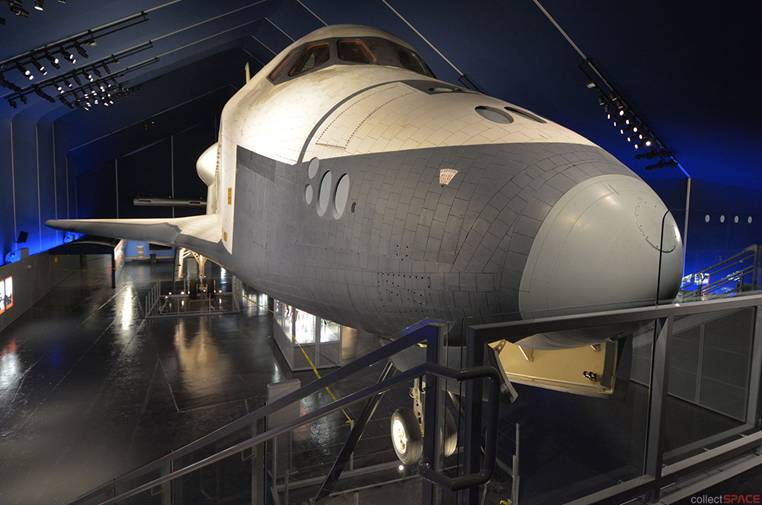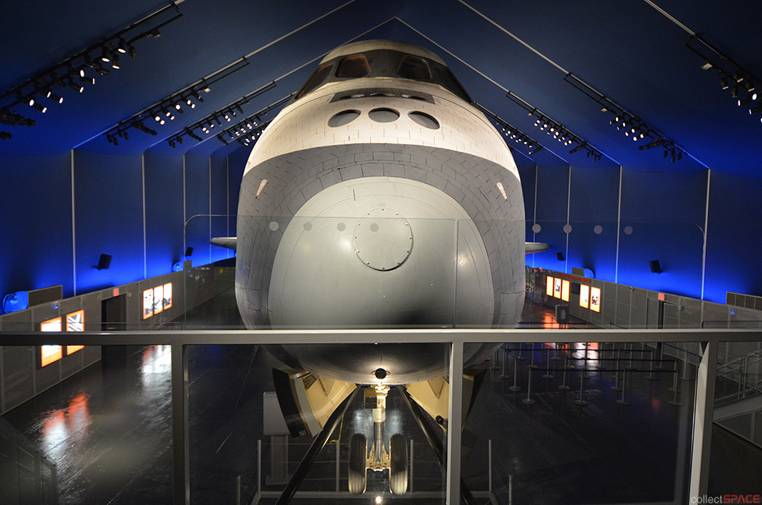Space Shuttle Enterprise 'Launches' for Second Time at NYC Museum

NEW YORK — Entering the Intrepid Sea, Air and Space Museum's new "Space Shuttle Pavilion," which opened in New York City on Wednesday (July 10), visitors are first greeted by the sound of astronauts exchanging radio calls with flight controllers about guiding a winged spacecraft to a safe touchdown.
The late-1970's audio recordings, which capture the critical approach and landing tests that preceded 30 years of U.S. space exploration, juxtapose the start of the space shuttle Enterprise's use as a NASA prototypewith its final role — located just a few more steps into the new pavilion — as a public attraction and educational exhibit.
Retired by NASA in 1985 and previously a part of the Smithsonian's collection, space shuttle Enterprisearrived at the Intrepid, a converted World War II aircraft carrier located on Manhattan's west side, in 2012. Enterprise's astronauts — the same whose voices are heard inside the pavilion's new "soundscape" entranceway — joined NASA, city and museum officials at the Intrepid to celebrate the shuttle's Big Apple debutlast July. [Video: Space Shuttle Enterprise in NYC]
Then, just three months later, Hurricane Sandy hit New York City, flooding the pier where the Intrepid is docked. The museum's original Space Shuttle Pavilion relied on air pressure to maintain its shape, so when the "superstorm" knocked out all the power, the enclosure deflated and was ultimately damaged beyond repair.
Enterprise was damaged, too. Its vertical stabilizer, or tail, was caught by the punctured pavilion and its tip broke off. Fortunately, the piece was recovered and reattached.
Now, eight months later, Enterprise has returned on public displayin an expanded exhibit and new, metal-supported pavilion. [Gallery: First Look at Shuttle Enterprise’s Second Pavilion]
On and above the flight deck
Get the Space.com Newsletter
Breaking space news, the latest updates on rocket launches, skywatching events and more!
Wednesday's ribbon cutting for the re-launched attractionincluded only a few local NASA center officials and none of the astronauts who were present for last year's opening. Though the fanfare was diminished, the enthusiasm was not, as the Intrepid's curators welcomed the waiting public inside.
"We are thrilled," Elaine Charnov, Intrepid's vice president of exhibits, told collectSPACE.com in an interview. "[This] establishes ... that we're recovering from Hurricane Sandy, but also continuing the educational venture that Intrepid is all about."
The shuttle pavilion sits on the aircraft carrier's flight deck. Enterprise itself, is mounted 10 feet (3 meters) above the deck, high enough that visitors can walk underneath it to view its deployed landing gear and mock heat shield tiles. Although constructed with an airframe identical to one of its space-flown sister ships, Enterprise was never made space-worthy. It was only used for atmospheric flight tests and ground-based trials.
Guests desiring a closer view of the orbiter can ascend to an observation platform offering a nose-to-nose encounter with the test shuttle.
The previous pavilion provided a raised-level view as well, but it quickly became crowded. The new exhibit features a larger platform.
"The expanded viewing platform is to enable the public to get a little bit closer and to accommodate more people at a time," Charnov said.
Enterprise is also no longer the only spacecraft to look at.
"We are super excited that we've now brought Soyuz into the pavilion so we can tell the comparative story about the two different space vehicles, which to some extent shared parallel missions," said Charnov.
Moved up from one of the Intrepid's lower decks, Russia's Soyuz TMA-6 capsule sits nearby the much larger shuttle. The three-seat spacecraft visited the International Space Station in 2005. Its return crew included Greg Olsen, who paid his way to orbit as a so-called "space tourist." Olsen now owns the spacecraft and has loaned it to the Intrepid for display.
Enterprise's sister space shuttles were retired to other museums in 2011. Since then, NASA has relied on Russia's Soyuz to ferry its astronauts to and from the space station. The space agency intends to hire private space companies to resume U.S.-based manned launches as soon as the new commercial spacecraft become available in 2017.

Expanding Enterprise
During the months that Enterprise's pavilion was closed to visitors, the Intrepid set up a temporary exhibit of artifacts and memorabilia aimed at recounting the orbiter's role as a pioneer. Those objects and more have been incorporated into the newly-opened display.
"We had already intended, now that [Enterprise has been here] for a year already, to add new content and stories," Charnov explained, adding that the storm-forced redesign provided the opportunity for that expansion.
"In contrast with the last exhibition, which was really about telling a story through lightboxes and captive frame grabs all along the walls, this gave us the opportunity to pause and recognize that this pavilion is massive — it's actually about a 19,000-square-foot stage — and people are going to be experiencing it in their own way and their own time," she added.
Rather than have guests follow a single narrative exhibit, the displays are now divided into zones, with each sharing a different aspect about the space shuttle and Enterprise. New exhibit areas inside the pavilion employ artifacts and multimedia to provide a closer look at the interior of the orbiter's interior, examine the space shuttle's influence on pop culture, and illustrate the 30-year program's impact on everyday life.
The exhibit also highlights the team of people who worked behind the astronauts to make sure that each mission was a success, as well as provide visitors an updated look at NASA's current and planned activities.
"We are really trying to celebrate history but also connect the public to what is going on now and what are some of the visions for the future," Charnov said. "Because history should be active."
The Intrepid Sea, Air & Space Museum is located at Pier 86 (46th Street and 12th Avenue) in Manhattan. Access to the Space Shuttle Pavilion costs $7 for adults and $5 for children ages 3 to 17, in addition to regular admission. The Intrepid is hosting a public SpaceFest, July 25-29, 2013, with NASA astronaut appearances, free movie screenings, hands-on demonstrations and more to celebrate all things space.
Follow collectSPACE.com on Facebook and on Twitter at @collectSPACE. Copyright 2013 collectSPACE.com. All rights reserved.
Join our Space Forums to keep talking space on the latest missions, night sky and more! And if you have a news tip, correction or comment, let us know at: community@space.com.

Robert Pearlman is a space historian, journalist and the founder and editor of collectSPACE.com, a daily news publication and community devoted to space history with a particular focus on how and where space exploration intersects with pop culture. Pearlman is also a contributing writer for Space.com and co-author of "Space Stations: The Art, Science, and Reality of Working in Space” published by Smithsonian Books in 2018.In 2009, he was inducted into the U.S. Space Camp Hall of Fame in Huntsville, Alabama. In 2021, he was honored by the American Astronautical Society with the Ordway Award for Sustained Excellence in Spaceflight History. In 2023, the National Space Club Florida Committee recognized Pearlman with the Kolcum News and Communications Award for excellence in telling the space story along the Space Coast and throughout the world.










